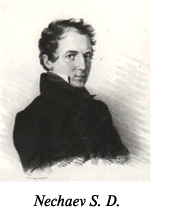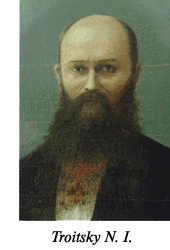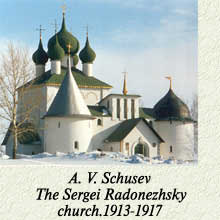|
The Russian troops formed up into the then traditional three line formation. The Outpost regiment was in the vanguard (head), the Front regiment was located behind it. The main line of the Russian battle parade had a three part division. The "Big" Moscow regiment was in the middle, its flanks were protected by the Right Hand and the Left Hand regiments. The reserves were located behind the "Big" regiment. The Russian generals, predicting the course of the battle, located an Ambush regiment in the Green woods to the east of the Left Hand regiment.
The Ambush regiment was formed fron the best cavalry troops. Because the flanks of the Russian host stood close to the Nizhni Dubik and Smolka river cliffs, which were covered with a thick forest, the Ambush regiment was well hidden. Mamai located his troops in a similar line formation. In the middle of the field the Horde had assembled hired Genoese infantry. On the flanks and behind the infantry were troops of the Horde’s cavalry and other hired warriors. Finally, Behind them were the reserves.
The battle began at about 11 o’clock in the morning with attacks by the Horde’s infantry and cavalry against the Outpost and Frontal regiments of Dimitry. Having survived the first attack, the remains of the Outpost and Frontal regiments retreated to the main Russian forces behind them. Fierce frontal attacks by the Horde’s cavalry began along all the defense lines of the Russian troops. They withstood these assaults, and Mamai decided to send his cavalry reserves against the Russian Left Hand regiment, in an attempt to create a break in the Russian lines. Despite strong resistance from the Russian troops on the Left flank, the Horde’s army managed to break through the Russian lines at this point.
Having lost a large percentage of its soldiers, the Left Hand regiment began to retreat. The rear reserves could not successfully hold the Hord's troops and, at approximately 2 o’clock in the afternoon, the Tatar cavalry moved toward the rear of the Russian troops, outflanking the Big regiment. There was a real threat of the Horde's cavalry surrounding and thereby destroying the Russian forces. This was a critical point in the battle. At this moment the Ambush regiment charged and attacked the rear of the Horde’s cavalry. The unexpected influx of fresh Russian troops changed the situation dramatically. The attack of the Ambush regiment was the signal for the Moscow regiments to assume the offensive.
The Tatars, who at this point had lost a significant number of troops, began a disorderly retreat. The Russian troops pursued them till late in the evening. It was a decisive and complete victory. The Golden Horde troops were completely destroyed, and the threat of total servitude to the Horde of the Russian principalities was eliminated. It is hard to even imagine what such a servitude would have been like.
The dead Russian warriors were picked from the field of battle and buried in the cemetary known as the "Bed of Honour" over a period of seven days. To that point in time, the Kulikovo battle was the largest battle of the Middle Ages. More than one hundred thousand warriors participated in it.
The Golden Horde was utterly defeated and, because of this, the battle on the field of Kulikova marked the turning point in the struggle of the greater Russian principalities against the Tatar-Mongol Yoke. It also greatly influenced the formation of a united Russian state, and the creation of a Russian national consciousness.
The Kulikovo battle has been an object of thorough study from the
points of view of political, diplomatic and cultural life in Russian
society over the last five centuries. According to one legend, the Russian Emperor Peter The Great, having visited the construction site of the watershed sluice on Ivan Lake, ordered his workers to mark the remaining oaks from the Green Woods in order that they not be cut down during the construction of the sluice.
Real interest in the Kulikovo Polye, though, arose in the first quarter of the 19 century.
 The first person to study the Kulikovo Polye in detail was Nechaev S.D. - a poet, and researcher of the region's history. Nechaev made several archeological findings on the place of the battle and, using those findings, created a small private museum. He was the first historian to carry out archeological research digs in an attemt to connect the historical description of the battle with the existing landscape. The first person to study the Kulikovo Polye in detail was Nechaev S.D. - a poet, and researcher of the region's history. Nechaev made several archeological findings on the place of the battle and, using those findings, created a small private museum. He was the first historian to carry out archeological research digs in an attemt to connect the historical description of the battle with the existing landscape.
Several other collections of archeological findings from the Kulikovo Polye were created, and as a result of this research, the construction of the first state sponsored monument dedicated to the memory of the Kulikovo battle were undertaken.
In 1820, following the initiative of Nechaev, the Governor of the provost of Tula, V.F.Vasilyev, wrote a petition to Emperor Alexander I requesting the creation of a monument to commemorate the achievements of Dimitry Donskoi at the Kulikovo Polye. In 1836 the Emperor Nikolai I approved the design of a cast iron monument created by A.P. Bryullov. In 1850 on September 8th the monument was officially opened in the presence of the governor, the representatives of the nobility and clergy, and local residents.
By the 500th anniversary of the Kulikovo battle, in the village of Monastyrshina, on the hallowed ground where the fallen warriors had been buried, a stone church was constructed. The church was consecrated by the presiding bishop of the Tula region in honour of the Nativity of the Theotokos. The birthday of the Theotokos and the day of the Kulikovo battle occured on one and the same day, the 8th of September. At the same time a parish school was constructed near the church.
|
|
On the 8th of September, 1880, crowds of
people witnessed a striking military parade and full artillery salute that took place at the monument dedicated to the memory of Dimitry Donskoi. The celebration of the jubilee gave impetus to historians of the Tula region to undertake renewed studies of the archeological history of the Kulikovo Polye. 
The well known Tula historian and public figure N.I. Troitsky visited the Kulikovo Polye three times in the 1880s, where he conducted archeological digs of the antiquities located in the Nepryadva river area. By the beginning of the 20th century the Tula Archdiocese's clergy decided to build a church on the Kulikovo Polye  dedicated to the memory of St. Sergius of Radonezh, the saint who blessed Dimitry to undertake the battle against the Tatars. dedicated to the memory of St. Sergius of Radonezh, the saint who blessed Dimitry to undertake the battle against the Tatars.
The creation of the design of the church was assigned to the architect Schusev A.V., who finished the work in 1911. The church had been under construction for four years, from 1913 through 1917 when the October revolution and the Civil war interrupted its construction. For almost 50 years, under the oppressive rule of the Soviet Gov't this field, upon which the blood of Russian warriors was spilt, and the begginings of the great Russian state took place, was forgotten.
In 1980 a new period in the history of the Kulikovo Polye was opened by decree of the government's committee of Cultural Affairs. To celebrate the 600th anniversary of the battle of Kulikovo the Committee declared the area a national park, and funded the completion of the church dedicated to the memory of St. Sergius of Radonezh on the Krasny Hill, the Nativity of the Theotokis church in the village of Monastyrshina, and the monument to Dmitry Donskoi. The memorial on Krasny Hill was also completed.
At the church of St. Sergius of Radonezh, a museum with an exhibition devoted to the Kulikovo battle was created under the leadership of specialists from the State Historical museum. In the middle of the field of battle these specialists reconstructed the Green Woods as they were understood to exist at the time of the battle.
The "Kulikovo Polye" national park is a most unique memorial, and a most valuable historical complex. Within the museum complex, numerous archeological objects, sculptures, and displays describing the region where the battle took place can be found. More than 380 items of archeological interest from various epochs that have been found on the Kulikovo field of battle are located here.
In general, the Kulikovo field remains one of the most important subjects of study of the ancient period of Russian history (similar to the surroundings of Chernigov and Suzdal). It represents a unique archeological area with 12 architectural monuments and 10 churches (built mainly in 19th -20th centuries), the most remarkable of which is the church dedicated to St. Sergius of Radonezh.
|

